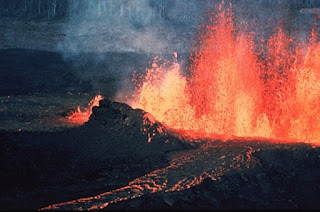Pangaea and Geology Failings
In the beginning, secular version, there was nothing — which exploded. Cosmic expansion and that sort of thing happened. Eventually, hot swirling gasses coalesced and formed the sun and planets. This story is the nebular hypothesis, which is full of holes but they like it better than alternatives.
Geologists in the secular science industry named their early time of Earth the Hadean Eon. That is based on the name of Hell (Luke 16:23, Rev. 20:13) and the Greek god of the underworld, Hades. Earth was supposedly cooling and the first crust was forming.
.jpg) |
| Erupting volcano, Wikimedia Commons / National Park Service (PD) |
If you studied earth science, one of the foundational concepts you would be familiar with is the theory of plate tectonics: movements of giant slabs of rock beneath the surface. This is a force responsible for mountain-building, earthquakes, volcanism and many other phenomena that earth experiences daily.Evolutionary-based education further exalts the role of plate tectonics and the associated volcanism and hydrothermal vents as the creative force behind earth and even a key driver for the conditions thought of as necessary for the chemical evolution of life. However, findings from a recent publication in Nature in April 2025 turned several evolutionary hypotheses of early plate tectonics on its head.
The rest of this hot topic is found at "No Plates for Pangaea: Tectonic Theories and Timelines Shift Again."